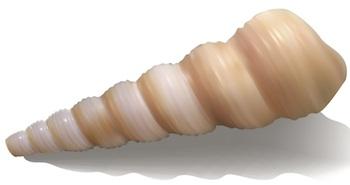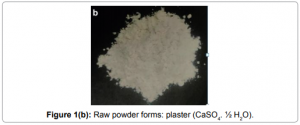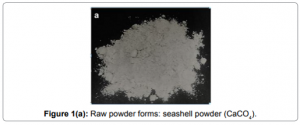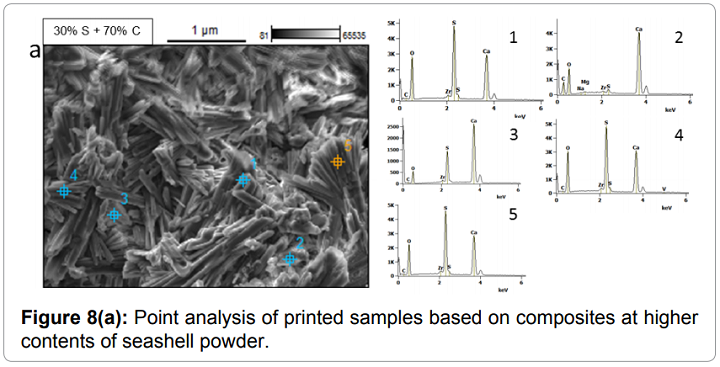It is inevitable that on a trip to the ocean, I will pick up and admire some seashells from the beach and contemplate bringing them home to display in a vase with sand, though I rarely follow through. Aside from how pretty they are, the powder that makes up seashells is actually a natural bioceramic material that’s been used before as an ingredient to produce lightweight, low-strength concrete for applications like pavers. Our very own 3DPrint.com writer Carmen Brio even used sea shells in 3D printing previously, using them as a filler for FDM filament that she made. Later on, students made filament from muscle shells as well. Now a collaborative team of researchers from Auckland University of Technology (AUT), Scion, and Beckmann-Institut für Technologieentwicklung in Germany were curious if seashell powder could be used in 3D printing, and published a paper, titled “Mechanism of Bonding in Seashell Powder Based Ceramic Composites Used for Binder-Jet 3D Printing,” that details their work.
The abstract reads, “Binder-jet 3D printing responses of sea-shell powder based ceramic composites have been evaluated considering the material consolidation mechanisms and mechanical characterisations. Initial experimental printing trials are done manually, varying the composition of the composite powders from 5% to 50% of the seashell powder and the rest plaster. Overall, the seashell and plaster combinations worked well in terms of achieving the necessary green strengths within the binder-jet process conditions. Scanning electron microscopy and 3-point bending results indicated no significant loss of properties at lower levels of the seashell component, but the strength decreased beyond the 25% mark. The optimum levels of seashell powder are found to be within 15-20% by weight in terms of the best compression strengths. Neat sea-shell powder however goes too sticky immediately after the interaction with the binder liquid and does not show evidence of any binding mechanism that can be accelerated.”
Because binder jetting is a popular AM technology for ceramics, the team evaluated how a variety of seashell powder compositions would respond to it, noting the “drastic differences in the setting mechanisms” between civil construction concrete and using binder jet 3D printing to generate complex forms. Applications in lightweight structures and energy management could open up if we’re able to better fabricate porous parts that have complex geometries.
“While the traditional cement setting takes longer times running into days, the 3D printing requires instantaneous setting as a certain amount of green strength is essential to be acquired within the short time, the powder sweeping arm comes with the next stroke. It is essential that an accelerated particle consolidation mechanism is at play, achieving the rapid green strength required to keep the previously consolidated layers intact, while the sweep spreads the next layer of the powder,” the researchers wrote. “The focus of this paper is to establish how seashell powders perform under these conditions.”
The team completed initial trials based on neat seashell powder, but it was inert when around moisture, which definitely won’t work – moisture being the basic triggering mechanism of 3D printing materials based in plaster. So they created plaster-seashell ceramic powder materials with varying compositions instead, and evaluated post-process responses based on mechanical and microstructural characterizations.
The researchers explained, “The binder-jet 3D printing method is employed for all the 3D printing trials undertaken as part of the current research. The commercial Z-Corp systems are usually the platforms for conducting such research. These systems are currently replaced by the 3D systems project versions, but the working principles are the same and in particular, the binder solution remains more or less the same. Considering the complications in altering the binder solutions, we have employed the same solution as is commercially available, which is equivalent to the Zb60 of the erstwhile Z-Corp materials options. All the specimens built as part of this research are based on the same Zb60 binder fluid. Considering the need to produce large quantities of materials in order to employ the actual printer, all the trials are done in a simulated binder-jet printing approach, where the powder is dispersed manually layer after layer in a plastic container, while the binder is jetted through a syringe. It may be noted that all the specimens are prepared based on make-shift printing arrangements and manually dispersing the binder. This is difficult to be calibrated, and the experiments are mainly intended to evaluate the preliminary responses of the new powder composites to processing by the binder jet method.”
Main attributes of any 3D printing powder are good spreading characteristics, reaction rates, and wetting angles. The team evaluated the seashell powders for these first, noting that the material quickly absorbs material and grows lumpy, so it can’t be spread out into the thin layer necessary for binder jetting. They observed reaction rates by treating powder samples with calculated amounts of liquid glue, and determined that the combination had “no reaction mechanisms at play.” The glue’s wetting angle over the surface is also dependent on how it interacts with the powder, as the glue flow on the powder’s surface is unable to be contained.
“Based on all these results, it was clear that seashell powder on its own cannot be a candidate material for 3D printing by the binder-jet method,” the researchers determined.
“Evidently, all three fundamental aspects required of a material candidate for 3D printing are not naturally available with the seashell powder and need to be fixed by means of adding other ingredients. After trying several alternatives, the plaster powder was identified as a good combination to form the seashell powder-ceramic composite that qualifies through all these three tests.”
The researchers also experimented with characterizing the seashell powder by combining it with plaster in a variety of weight proportions.
“The binder glue is taken in a syringe and deposited on to the layers manually. Rectangular samples are prepared for 3-point bending tests,” the researchers wrote. “For each layer, the required amount of powder deposited on to the substrate and then spread uniformly using a wooden spatula, maintaining the layer thickness to be around 1mm. Then a calculated amount of the binder fluid is added to the layer moving the syringe in a zig-zag raster path pattern. The process is repeated to build ten layers and once all the layers are printed, the specimens are left to cure for at least 6 hours before taking them out.”
SEM photomicrographs of the 3D printed specimens were taken, EDS analysis was completed in order to “substantiate the observations” on the growth and formation of gypsum crystals and seashell powder dispersion, and the researchers also performed point analysis to “ascertain the predictions around the dispersion of the seashell powder within the gypsum crystal network.” Finally, they subjected the 3D printed rectangular blocks, fabricated with a variety of compositions, to three-point bending tests in order to determine mechanical properties, and found that the 3D printed pure plaster specimen had the best maximum compressive resistance. Interestingly, adding seashell powder actually helped deteriorate this resistance, which is obviously not the goal.
“Overall, seashell powder and plaster combinations are proved to be suitable for 3D printing by the binder-jet process. However, the seashell powder has no inherent reactivity or mechanism to enhance the bonding strength,” the researchers concluded. “It will remain in the crystal network of the gypsum phase and will not deteriorate the mechanical properties up to 15-20% by weight. Beyond this, the compressive strengths will be too low and the printed samples will be too fragile. The ability to include up to 20% by weight of the seashell powder in itself is an interesting finding as the powder composite brings biological flair into the material system and also ticking the boxes with sustainability.”
Co-authors of the paper are S. Singamneni, M.P. Behera, Morgan Le Guen, and Henning Zeidler.
Discuss this and other 3D printing topics at 3DPrintBoard.com or share your thoughts below.
Subscribe to Our Email Newsletter
Stay up-to-date on all the latest news from the 3D printing industry and receive information and offers from third party vendors.
Print Services
Upload your 3D Models and get them printed quickly and efficiently.
You May Also Like
3D Printing News Briefs, June 4, 2025: Full-Color Slicer, Denture Implants, & More
In today’s 3D Printing News Briefs, we’ll start with some software and post-processing news, and then move on to a case report in which digital dentistry was successfully used. Read...
Croom Medical Launches TALOS Technology Platform for 3D Printed Tantalum
Irish company Croom Medical, specializing in precision manufacturing for orthopedic implants, has officially launched the TALOS technology platform for 3D printed tantalum (Ta) components. The platform was developed in collaboration...
CEAD and Damen Partnering to Develop HDPE 3D Printed Workboat
Dutch 3D printing firm CEAD partnered with Damen Compact Crafts (DCCr), part of the Damen Shipyards Group, to develop a 3D printed HDPE workboat. CEAD makes gantry and robot arm-based...
3D Printing News Briefs, May 21, 2025: Medical Training Models, Connectors, Makerspace, & More
We’re starting with research and medical in today’s 3D Printing News Briefs, as a research team from Caltech is using sound to 3D print deep inside living tissue, and rural...







































